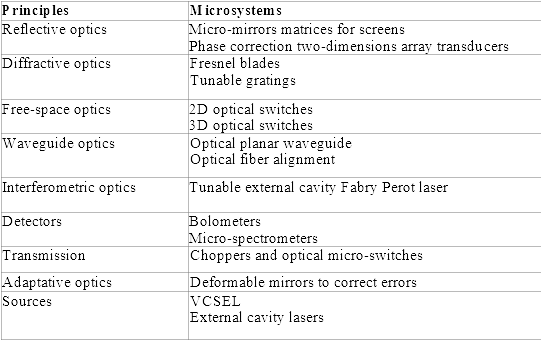Introduction
Walker and Nagel studied and listed the various micro-technologies for optical applications and proposed to classify them according to the type of micro-optics used and the optical functions set up such as: sources, detectors, free-space optics, waveguide optics, transmission optics, reflective, diffractive and interferential optics (see the chart below):

Micro-mirrors are used to point an optical beam at an optical waveguide, in or out of an optical fiber, and to turn light. Many systems functioning in a reflective mode were directly set up on silicon, on metallic surfaces or in multilayer systems with different refractive indexes. For instance, VCSEL (Vertical Cavity Surface Emitting Laser) is a micro-system implemented from a multiple pileup of different index layers in order to obtain very high reflexion coefficients.
Micro-mirror matrix is the widest application of optical micro-systems and is mainly used for projection display systems and for free-space optical communication.
The diffractive optics makes it possible to make planar micro-lenses, Fresnel lenses and gratings.
In the systems we just talked about, the light spreads in free-space before reaching the actuator that deflects or diffracts it. Another alternative to control light: to confine it in an optical planar wavelength. It's then impossible to interact directly with it, however we can modify its spread by positioning an actuating micro-system near enough to the planar wavelength for a possible coupling by the evanescent wave. The coupling by evanescent wave results in a stage delay that can be used to make optical switching and so on.
Research in micro-systems highlighted many devices. Some of them became commercial successes, and some not yet. We noticed that miniaturization is not sufficient to create new markets or to become more competitive. The most successful optical micro-systems combine at least two or three factors we already mentioned: possibility to set up micro-device matrices, ability to reset optical properties and nanoscale control of precision of positioning.